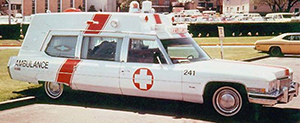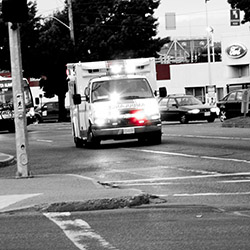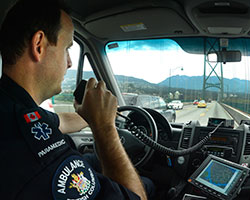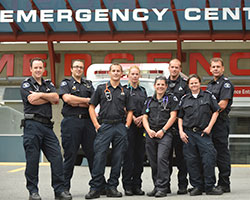 In 1974, the British Columbia Government created the BC Ambulance Service, in response to problems with ambulance services differing significantly from community. At the time, small private ambulance providers created at patchwork of coverage. Citizens couldn’t reliably know that when they were in crisis, a Paramedic staffed ambulance would be available to them.
In 1974, the British Columbia Government created the BC Ambulance Service, in response to problems with ambulance services differing significantly from community. At the time, small private ambulance providers created at patchwork of coverage. Citizens couldn’t reliably know that when they were in crisis, a Paramedic staffed ambulance would be available to them.
The creation of a provincial ambulance service aimed to ensure all British Columbians would have reliable ambulance services at their disposal. This model proved to be years ahead of its time, as many other provinces are transitioning to such a structure only now. A provincial service removes any artificial boundaries, allowing resources to be shared from community to community.
Current Challenges
 Today, British Columbia faces a new struggle with ambulance services. Many larger sized British Columbia communities are facing serious Paramedic response time delays and hospital overcrowding. While density levels and population has steadily increased in metropolitan areas, the number of ambulances servicing these areas has had little or no increase over the last 15 years. As strained hospitals struggle to manage this increasing workload, more and more ambulances end up stuck at hospitals so Paramedics can care for patients waiting for assessment.
Today, British Columbia faces a new struggle with ambulance services. Many larger sized British Columbia communities are facing serious Paramedic response time delays and hospital overcrowding. While density levels and population has steadily increased in metropolitan areas, the number of ambulances servicing these areas has had little or no increase over the last 15 years. As strained hospitals struggle to manage this increasing workload, more and more ambulances end up stuck at hospitals so Paramedics can care for patients waiting for assessment.
In addition to the challenges above, metropolitan communities suffer from increasing ambulance call volumes. A portion of this call volume is comprised of ‘frequent callers’ or other types of requests, which do not require treatment at an emergency department. This type of call volume ties up valuable resources, which compounds the problem of already suffering response times.
The BC Ambulance Service must respond to these challenges by adapting to local needs and ensuring a reliable service to connect patients to the care they require.
Community Based Solutions
No two communities have the same ambulance and healthcare problems, so solutions must be found which fit each specific area’s need. BC Paramedics are a key part of BC’s healthcare team and can be part of those solutions. Recent projects in Burns Lake and Midway are examples of how the BCAS, the Health Authority and the Paramedics union can work collaboratively to find unique solutions.
Other large Canadian cities have tackled these issues in multiple ways. All of these strategies have one thing in common: the use of a robust Community Paramedicine program. These programs have been proven to both reduce 911-call volume and reduce unnecessary hospital emergency visits. Some examples of metropolitan successes are:
 Toronto EMS Community Paramedicine Program – For over 10 years, Canada’s largest city has been using a thriving Community Paramedicine program to help their patients. With a focus on health promotion and injury prevention, they are ensuring the right resources are connected to the right patients.
Toronto EMS Community Paramedicine Program – For over 10 years, Canada’s largest city has been using a thriving Community Paramedicine program to help their patients. With a focus on health promotion and injury prevention, they are ensuring the right resources are connected to the right patients.
This diverse program focuses on identifying those in the community who can be treated in their homes, rather than being transported to emergency departments. Unique seasonal programs aim to prevent heat injuries in the summer and protect from cold injuries in the winter months. They provide immunizations in the field to homeless and low-income citizens, helping prevent the spread of treatable disease.
All of these strategies combine to reduce unnecessary 911 calls and emergency visits, saving significant money in the healthcare budget. Learn more here
Hamilton Paramedic Service Community Paramedics – In the Hamelton area, the Community Paramedicine program features three main aspects:
CREMS – Community Referral by EMS – A system where responding Paramedics can identify patients at risk for loss of independence or a health crisis at home. Referrals then ensure patients are linked to the proper care, preventing future 911 calls and allowing patients to remain living at home.
Social Navigator Program – Combining a Community Paramedic with police services to address the area’s mental health patients. Regular visits and checkups by the social navigator team keep emergency ambulance and police resource free for other more urgent events.
Strathcona Project – A program that used ‘Duty to accommodate’ Paramedics to visit the area’s low-income populations. This Community Paramedic performs care assessments and promotes good health practices to ensure this higher risk population is able to live safely in their homes.
 Winnipeg Community Paramedics – Recently launched in 2012, the Winnipeg Community Paramedic pilot project took aim at the same aspect of programs in other larger centres.
Winnipeg Community Paramedics – Recently launched in 2012, the Winnipeg Community Paramedic pilot project took aim at the same aspect of programs in other larger centres.
The main two aspect of this service target care facilities and other frequent ambulance users. In the first five months, the Community Paramedics assessed 8000 patients. These assessments resulted in only 161 transports to hospital. That number represents a significant drop from 350 to 400 transports to hospital in the previous five months.
These are just a few examples of how Community Paramedics can be a part of the solution for the issues facing healthcare delivery in BC’s larger cities.
In British Columbia, the provincial government has an obligation to provide ambulance services to each and every citizen of the province. This provincial model has been shown as the most efficient delivery model in the industry. In fact, Alberta is currently transitioning from a municipal ambulance model to a BC-style provincial model. Many other provinces are following suit as well.
While the BCAS faces significant struggles in many areas, we must find solutions to those struggles within the provincial structure model. The downloading of ambulance services to municipalities or private companies would take our province back almost 40 years in progress. Such a backward move would simply transfer the obligation and costs of ambulance delivery to municipal taxpayers, while failing to solve the real issues.
In order for new programs, such as Community Paramedicine, to be developed, it is critical that the key stakeholders are able to work directly with each other. Currently, the bargaining for Paramedic and Ambulance services occurs within the Facilities Bargaining Association (FBA). Paramedics are a small part of the 45,000 employees encompassed by the FBA. As a result, discussions on Paramedic specific issues are often lost in the larger scheme. This has resulted in year after year of failed progress to resolve ambulance delivery issues. In order to discuss solutions, it is critical that Paramedics be removed from the FBA, into a separate and distinct bargaining association.
Taking Action For Your Community
Municipal representatives have a critical role in the decisions being made about healthcare services in your community. You know the needs of your community better than anyone else.
 It is time that solutions to the ambulance and healthcare issues faced by rural communities come to the forefront of British Columbia government discussions.
It is time that solutions to the ambulance and healthcare issues faced by rural communities come to the forefront of British Columbia government discussions.
We ask that you write both the Health Minister and Health Critic to express your concerns for the state of ambulance services and healthcare in your community.
We ask that you highlight:
- Your unique community issues
- Your support for new programs like Community Paramedicine
- Your support for bargaining structure changes to get these discussions started
We also ask you to spread the word. Share your thoughts and issues with your colleagues around the province. When each and every rural community comes together to demand solutions, big ideas can quickly take shape.
The Ambulance Paramedics of BC is ready to get to work on finding solutions for your community. If you have any further questions about our ideas, or would like to discuss them further, please contact us HERE
